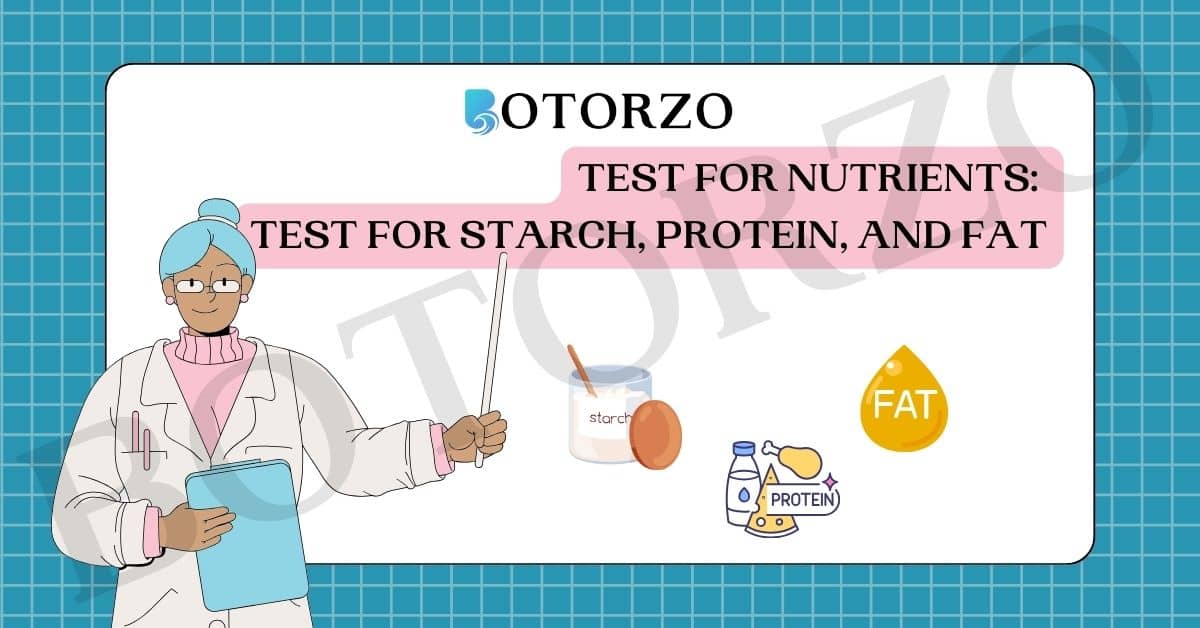
In today’s world of nutrition and dietary awareness, understanding the composition of the food we consume is crucial. Starch, protein, and fat are three fundamental components that make up a significant part of our daily diet. But how can we test for the presence of these essential nutrients? In this comprehensive guide, we will explore different methods to test for starch, protein, and fat, ensuring that you can make informed choices about your food.
Introduction
Testing for starch, protein, and fat is not only a scientific endeavor but also a practical one. It helps individuals with dietary restrictions, athletes looking to optimize their nutrition, and anyone interested in leading a healthier lifestyle.
Why test for nutrients?
Understanding the nutrient content of food is essential for various reasons. Whether you want to control your carbohydrate intake, boost your protein intake, or monitor your fat consumption, knowing how to test for these nutrients empowers you to make better choices.
Testing for Starch
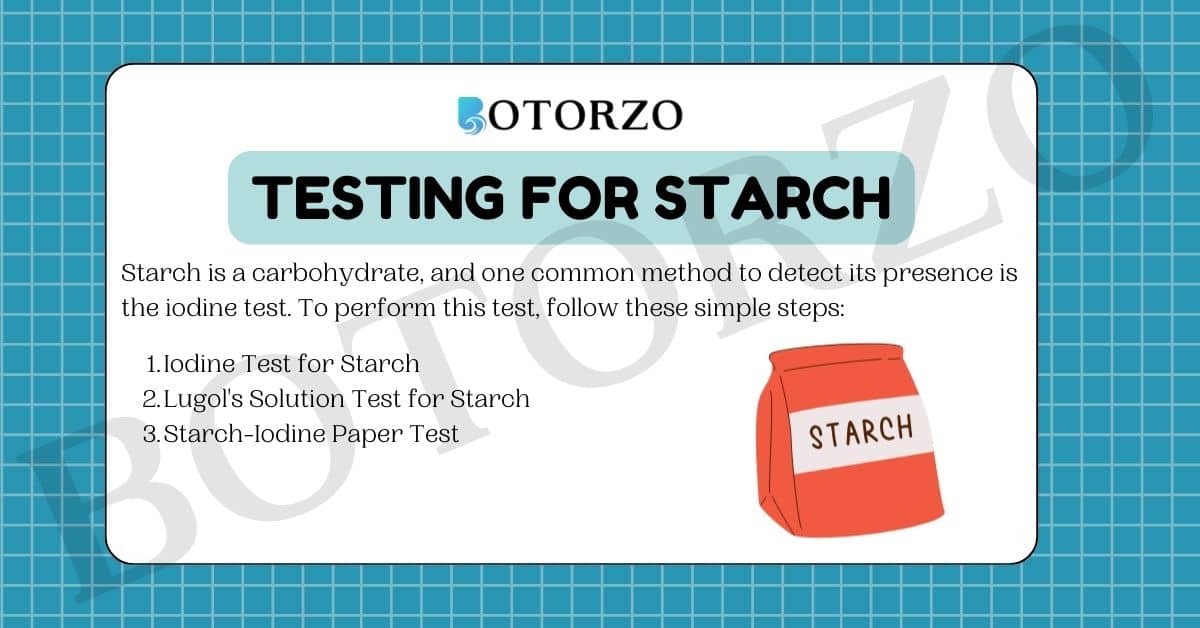
Starch is a carbohydrate, and one common method to detect its presence is the iodine test. To perform this test, follow these simple steps:
Iodine Test for Starch
- Take a small amount of the food sample.
- Apply a few drops of iodine solution to the sample.
- Observe the color change. If the sample turns blue-black, it contains starch.
Another way to detect starch in a food item is the Lugol’s solution test.
Lugol’s Solution Test for Starch
- Take a small food sample.
- Add a few drops of Lugol’s solution.
- Look for a blue-black color change. If it occurs, starch is present.
You can also use the starch-iodine paper test.
Starch-Iodine Paper Test
- Place a small food sample on a piece of starch-iodine paper.
- Observe the paper for a color change. If it turns blue-black, starch is present.
Read Also
Testing for Protein
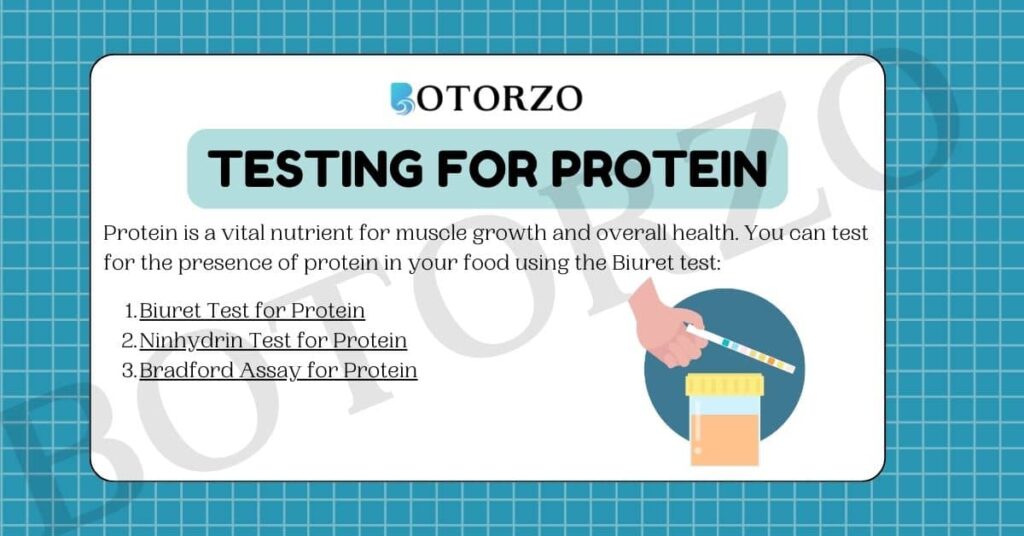
Protein is a vital nutrient for muscle growth and overall health. You can test for the presence of protein in your food using the Biuret test:
Biuret Test for Protein
- Take a sample of the food.
- Add a few drops of Biuret reagent.
- Observe the color change. A violet or purple color indicates the presence of protein.
Another method to detect protein in food items is the ninhydrin test.
Ninhydrin Test for Protein
- Take a food sample.
- Apply a few drops of ninhydrin solution.
- Look for a purple color change, which indicates the presence of protein.
You can also use the Bradford assay, a quantitative method to determine protein concentration:
Bradford Assay for Protein
- Prepare a standard curve using known protein concentrations.
- Add a sample of your food to the Bradford reagent.
- Measure the absorbance and compare it to the standard curve to determine the protein concentration.
Testing for Fat
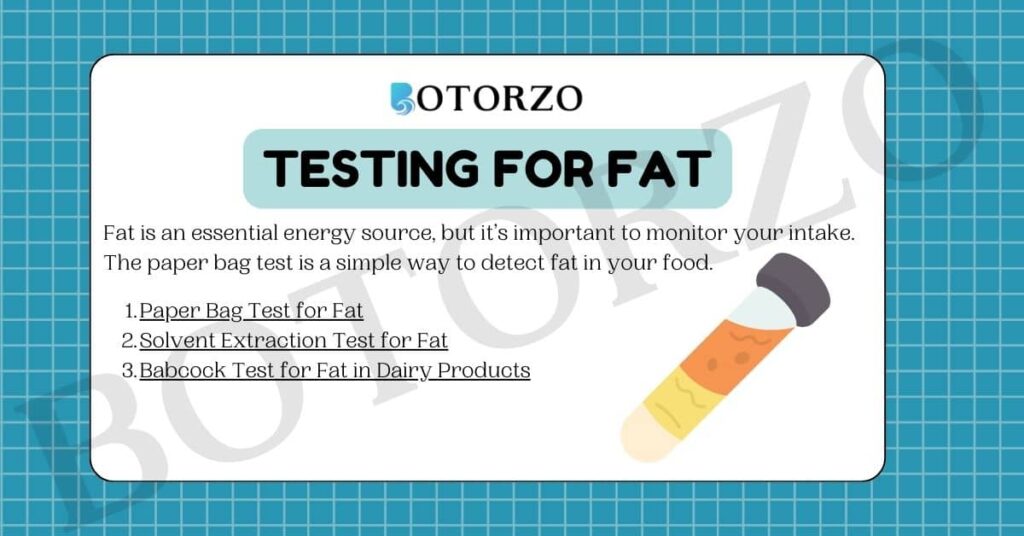
Fat is an essential energy source, but it’s important to monitor your intake. The paper bag test is a simple way to detect fat in your food.
Paper Bag Test for Fat
- Place a small sample of the food in a paper bag.
- Seal the bag and wait for a few minutes.
- If the bag becomes translucent due to oil stains, the food contains fat.
For a more accurate fat test, you can use the solvent extraction method:
Solvent Extraction Test for Fat
- Grind the food sample into a fine powder.
- Mix the powder with a solvent like ether.
- After filtration, evaporate the solvent, leaving behind the fat.
The Babcock test is another method to determine fat content in dairy products:
Babcock Test for Fat in Dairy Products
- Mix a known quantity of the dairy sample with sulfuric acid and amyl alcohol.
- Centrifuge the mixture to separate the fat.
- Measure the fat layer’s volume to determine the fat percentage.
Difference Table Between All Test
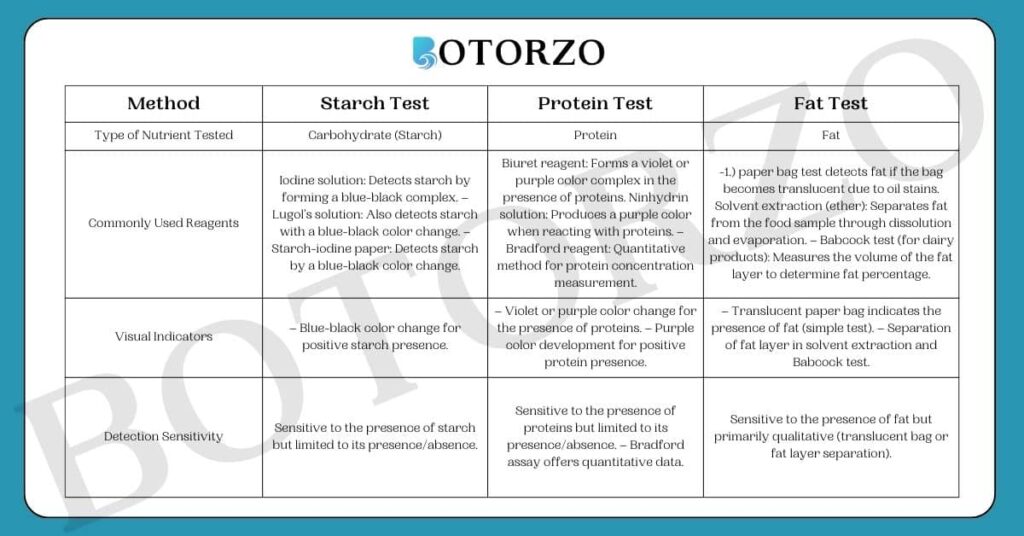
| Method | Starch Test | Protein Test | Fat Test |
|---|---|---|---|
| Type of Nutrient Tested | Carbohydrate (Starch) | Protein | Fat |
| Commonly Used Reagents | Iodine solution: Detects starch by forming a blue-black complex. – Lugol’s solution: Also detects starch with a blue-black color change. – Starch-iodine paper: Detects starch by a blue-black color change. | Biuret reagent: Forms a violet or purple color complex in the presence of proteins. Ninhydrin solution: Produces a purple color when reacting with proteins. – Bradford reagent: Quantitative method for protein concentration measurement. | -1.) paper bag test detects fat if the bag becomes translucent due to oil stains. Solvent extraction (ether): Separates fat from the food sample through dissolution and evaporation. – Babcock test (for dairy products): Measures the volume of the fat layer to determine fat percentage. |
| Visual Indicators | – Blue-black color change for positive starch presence. | – Violet or purple color change for the presence of proteins. – Purple color development for positive protein presence. | – Translucent paper bag indicates the presence of fat (simple test). – Separation of fat layer in solvent extraction and Babcock test. |
| Detection Sensitivity | Sensitive to the presence of starch but limited to its presence/absence. | Sensitive to the presence of proteins but limited to its presence/absence. – Bradford assay offers quantitative data. | Sensitive to the presence of fat but primarily qualitative (translucent bag or fat layer separation). |
| Quantitative Measurement | Mostly qualitative, limited to presence/absence of starch. | Mostly qualitative, limited to presence/absence of proteins. – Bradford assay provides quantitative protein concentration. | Qualitative (simple paper bag test) or quantitative (solvent extraction for fat content, Babcock test for fat percentage). |
| Ease of Use | Simple and quick procedures. | Simple and quick procedures. – Bradford assay is more involved. | Simple (paper bag test) or more complex (solvent extraction, Babcock test). |
| Applicability to Processed Foods | Suitable for both raw and processed foods. – Some foods may yield false positives due to other compounds reacting with iodine. | Suitable for both raw and processed foods. – Presence of other substances (e.g., reducing sugars) may interfere with the test. – Bradford assay may require sample preparation. | Suitable for both raw and processed foods. – More accurate results obtained through solvent extraction and Babcock test. |
| Additional Considerations | – Provides limited information about starch quantity. – May yield false positives in some cases. | – The presence of other substances (e.g., reducing sugars) may interfere with the test. – Bradford assay is a precise quantitative method. | – Limited to detecting the presence of fat. – Solvent extraction and Babcock test provide more accurate fat content information. |
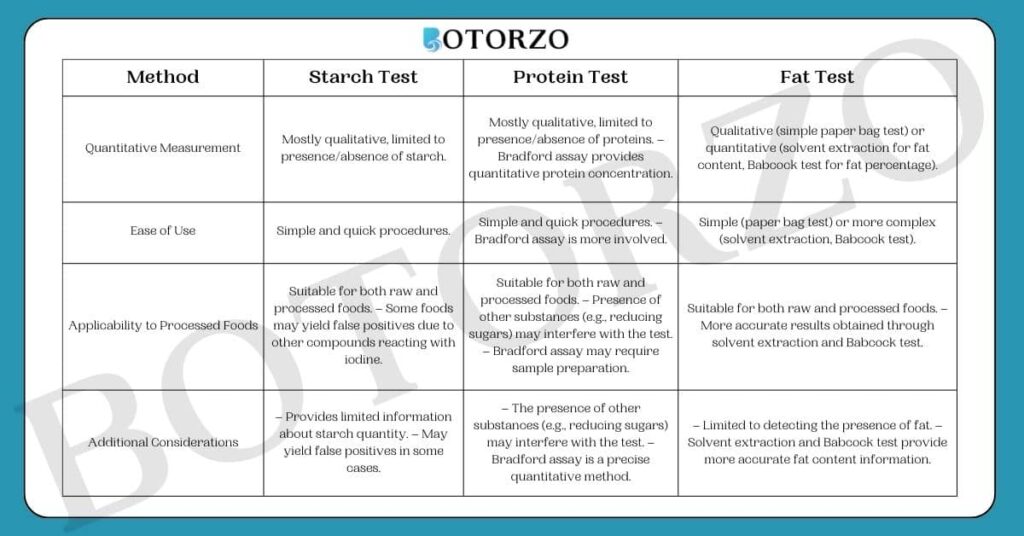
Conclusion
Testing for starch, protein, and fat is essential for anyone interested in a balanced and healthy diet. Whether you’re managing dietary restrictions or striving for optimal nutrition, these tests empower you to make informed choices about your food.
FAQs
is it necessary to test for nutrients in every meal?
It’s not necessary for every meal, but it can be helpful to periodically test your food to track your nutrient intake.
Are there any risks associated with these tests?
These tests are generally safe to perform, but it’s essential to follow the instructions carefully.
Can I use these tests for processed foods?
Yes, these tests are suitable for both raw and processed foods.
What are some other methods to test for nutrients?
There are advanced methods like spectroscopy and chromatography, primarily used in laboratories.
Are there specific tests for vitamins and minerals?
Yes, vitamins and minerals require different testing methods, such as spectrophotometry and titration
